
Shinobi (忍) is a side-scrolling hack-and-slash action game produced by Sega, originally released for arcades on the Sega System 16 board in 1987. The player controls ninja Joe Musashi, to stop the Zeed terrorist organization from kidnapping students of his clan.
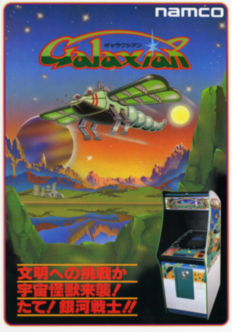
Galaxian is a 1979 fixed shooter arcade video game developed and published by Namco. The player assumes control of the Galaxip starfighter in its mission to protect Earth from waves of aliens. Gameplay involves destroying each formation of aliens, who dive down towards the player in an attempt to hit them.
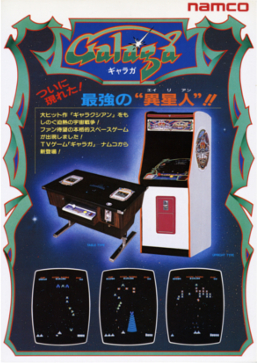
Galaga is a 1981 fixed shooter arcade video game developed and published by Namco. In North America, it was released by Midway Manufacturing. It is the sequel to Galaxian (1979), Namco's first major video game hit in arcades. Controlling a starship, the player is tasked with destroying the Galaga forces in each stage while avoiding enemies and projectiles. Some enemies can capture a player's ship via a tractor beam, which can be rescued to transform the player into a "dual fighter" with additional firepower.

Dig Dug is a maze arcade game developed by Namco in 1981 and released in 1982, distributed in North America by Atari, Inc. The player controls Dig Dug to defeat all enemies per stage, by either inflating them to bursting or crushing them underneath rocks.

Xevious is a vertically scrolling shooter video game developed and published by Namco for arcades in 1982. It was released in Japan and Europe by Namco and in North America by Atari, Inc. Controlling the Solvalou starship, the player attacks Xevious forces before they destroy all of mankind. The Solvalou has two weapons at its disposal: a zapper to destroy flying craft, and a blaster to bomb ground installations and enemies. It runs on the Namco Galaga arcade system.

Robotron: 2084 is a multidirectional shooter developed by Eugene Jarvis and Larry DeMar of Vid Kidz and released in arcades by Williams Electronics in 1982. The game is set in the year 2084 in a fictional world where robots have turned against humans in a cybernetic revolt. The aim is to defeat endless waves of robots, rescue surviving humans, and earn as many points as possible.
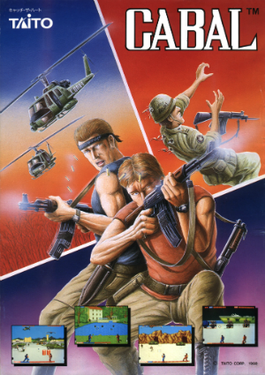
Cabal is a 1988 arcade shooter video game originally developed by TAD Corporation and published in Japan by Taito, in North America by Fabtek and in Europe by Capcom. In the game, the player controls a commando, viewed from behind, trying to destroy various enemy military bases. The game was innovative for the era, but only a mild success in the arcades, and became better known for its various home conversions.

Pac-Land is a 1984 side-scrolling arcade platform game developed and released by Namco. It was distributed in North America by Bally Midway, and in Europe by Atari Games. Controlling Pac-Man, the player must make it to the end of each stage to return a lost fairy back to its home in Fairyland. Pac-Man will need to avoid obstacles, such as falling logs and water-spewing fire hydrants, alongside his enemies, the Ghost Gang. Eating large flashing Power Pellets will cause the ghosts to turn blue, allowing Pac-Man to eat them for points.
Though not a complete history, herein is a list of what many would consider most of the "game" changers that made arcade experiences so powerful and nostalgic.
1974 had new titles such as Speed Race, Dungeon, Gran Trak 10, Tank and TV Basketball. The year's best-selling arcade game was Tank by Kee Games.
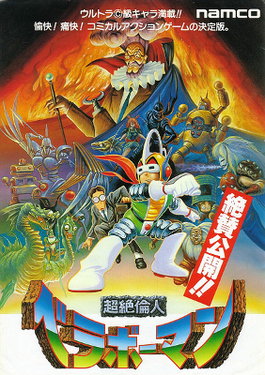
Chōzetsurin Jin: Bravoman is a 1988 beat'em up arcade game developed and published in Japan by Namco. Described as a "comical action game", the player controls the titular character, a bionic superhero with telescopic limbs, as he must defeat the villainous Dr. Bomb before he takes over the world. Bravoman can use his arms, legs and head to defeat enemies, and can also crouch and jump over them. The game ran on the Namco System 1 arcade board.

Galaga '88 is a 1987 fixed shooter arcade video game by Namco. It is the third sequel for Galaxian. It features significantly improved graphics over the previous games in the series, including detailed backgrounds, larger enemies and greater ship details. The game runs on Namco System 1 hardware.
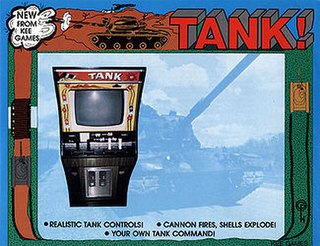
Tank is an arcade game developed by Kee Games, a subsidiary of Atari, and released in November 1974. It was the only original title not based on an existing Atari property developed by Kee Games, which was founded to sell clones of Atari games to distributors as a fake competitor prior to the merger of the two companies. In the game, two players drive tanks through a maze viewed from above while attempting to shoot each other and avoid mines, represented by X marks, in a central minefield. Each player controls their tank with a pair of joysticks, moving them forwards and back to drive, reverse, and steer, and firing shells with a button to attempt to destroy the other tank. The destruction of a tank from a mine or shell earns the opposing player a point, and tanks reappear after being destroyed. The winner is the player with more points when time runs out, with each game typically one or two minutes long.

Grobda is a 1984 multidirectional shooter arcade video game developed and published by Namco. It is a spin-off from Xevious, as the player's tank first appeared in that game as an enemy. It runs on Namco Super Pac-Man hardware but with a video system like that used in Mappy and The Tower of Druaga, and it also uses a DAC for the "Get Ready" speech sample at the start of each round.

Dragon Spirit is a 1987 vertical-scrolling shooter arcade game developed and published by Namco. In North America, it was distributed by Atari Games. Controlling the dragon Amul, the player must complete each of the game's nine areas to rescue the princess Alicia from the demon Zawell. Similar to Namco's own Xevious, Amul has a projectile weapon for destroying air-based enemies and a bomb for destroying ground enemies. It ran on the Namco System 1 arcade board.
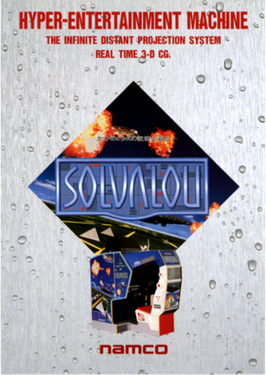
Solvalou is a 1991 first-person rail shooter arcade game developed and published in Japan by Namco. The sixth entry in the Xevious series, the player takes control of the Solvalou starship from a first-person perspective as it must destroy the Xevious forces before they take control of Earth. The Solvalou has two weapon types: an air zapper to destroy air-based enemies, and a blaster bomb to destroy ground-stationed enemies. It runs on the Namco System 21 arcade board.

Metal Hawk is a 1988 multidirectional shooter arcade game developed and published by Namco. Assuming control of the titular attack helicopter, the player is tasked with using a machine gun and air-to-surface missiles to destroy enemies and earn a certain number of points before the timer runs out, all while avoiding collision with ether enemy projectiles and obstacles. The Metal Hawk can change its altitude to allow it to either rise higher in the air or lower towards the ground. It ran on the Namco System 2 arcade board.

NebulasRay is a vertical-scrolling shooter arcade game developed and released by Namco in 1994. Players take control of a starship named the Fighting Ray through a series of levels in its mission to eradicate the universe of an intergalactic organization named the Master Force. It is noteworthy for its usage of pre-rendering, where 3D models are converted into 2D sprites, creating the illusion of a 3D world.

Escape from the Planet of the Robot Monsters is a multidirectional shooter released in arcades by Atari Games in 1989. The game is styled after campy science fiction B movies of the 1950s. It was ported to the Amiga, Amstrad CPC, Atari ST, Commodore 64, MS-DOS, SAM Coupé, and ZX Spectrum.
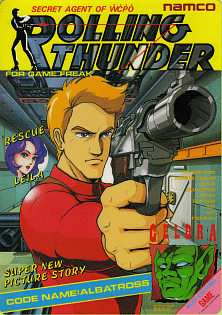
Rolling Thunder is a run-and-gun shooter produced by Namco, originally released as a coin-operated arcade video game which ran on the Namco System 86 hardware in 1986. It was distributed in North America by Atari Games. The player takes control of a secret agent who must rescue his female partner from a terrorist organization. Rolling Thunder was a commercial success in arcades, and it was released for various home computer platforms in 1987 and the Nintendo Entertainment System in 1989. The original arcade game has been included in various classic game compilations as well. It influenced later arcade action franchises such as Shinobi and Time Crisis, which borrowed mechanics such as taking cover behind crates.




















